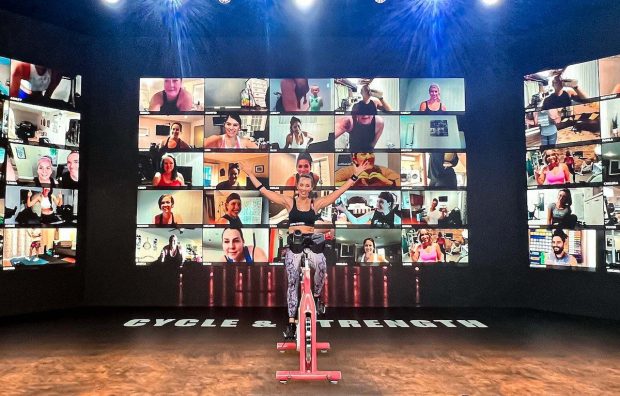Hybrid Home, Gym Experience May be the Future of Connected Fitness

As consumers continue to return to many of their pre-pandemic behaviors, physical gyms, one of the hardest-hit parts of the economy, are likely hoping people will hop off the stationary bikes in their living rooms and come back to classes that were a staple of many routines.
But Carl Daikeler, co-founder, chairman and CEO of The Beachbody Company, isn’t so sure that’s how it will play out. “The best way to stay consistent with your health and fitness is to make it as convenient as being in your living room,” he told PYMNTS.
Daikeler said Beachbody saw a surge in post-COVID at-home fitness spending of 30 to 40%, and average workouts per active user per month have remained strong throughout 2021 as people continue to embrace at-home health and wellness. Beachbody projects that the connected fitness market will reach $59 billion by 2027.
“People love their gyms, but they also love the convenience of a hybrid model — exercising at the gym when they have time, but at home the rest of the time,” Daikeler said. “That’s why at-home fitness is here to stay.”
PYMNTS’ Connected Economy research shows that one-third of all consumers are highly connected in the health pillar, including over half of millennials. Additionally, a Wakefield study cited by Beachbody found that 87% of people say they will keep at-home fitness as a part of their workout routine even after they feel comfortable returning to the gym, which Daikeler noted is “just among those who already incorporate fitness into their lives.”
Related: Study: How 73 Million Highly Connected Consumers Are Pioneering The Connected Economy
Over the next two years, the Beachbody CEO said, customers will see “some of our biggest innovations,” including new ways of engaging with content on the company’s connected indoor bike. One of these innovations, launched last month, is Beachbody On Demand Interactive — known as BODi — a new premium tier of the Beachbody On Demand subscription that offers a live, connected group exercise experience.
With the launch of BODi, Daikeler said, Beachbody has “taken a significant step forward in enhancing the at-home experience,” making consumers part of the “cast” by broadcasting them a screen behind the instructor.
“Where I see the greatest opportunity is in leveraging technology to enhance the human experience, and drive both the connection and accountability that is so critical for achieving goals,” he said.
Steep Competition
To be sure, Beachbody is up against fierce competition in the connected fitness space. Peloton, though struggling to a certain extent to recover from injuries caused by and a subsequent recall of its treadmills, still managed to grow its connected fitness subscriptions by 114% and paid digital subscriptions by 176% in the quarter ended June 30; the company is set to report earnings for its first quarter of the fiscal year Thursday (Nov. 4).
Related: Peloton Connected Fitness Subscriptions Grow 114 Percent
Additionally, several startups, such as Aviron, see an opportunity to appeal to consumers in new and different ways, such as gamifying a workout or offering alternatives to the most prevalent workout equipment. Apple and Amazon are also both working to expand their fitness offerings through new devices and classes. Amazon last month, for example, released a new version of its Halo fitness tracking device that has a screen, as well as Halo Nutrition, a platform to help build healthy eating habits, and Halo Fitness, a new service with hundreds of studio-quality workout classes akin to Apple Fitness+.
See more: Amazon Halo Expansion Could Upend Connected Fitness Space
What’s unique to Beachbody, Daikeler told PYMNTS, is the offer of “a complete solution that includes fitness, nutrition and community.”
“The pandemic has brought to light the importance of health and wellness to entirely new segments of the population,” he said. “And Beachbody is uniquely positioned to meet their needs because we’ve been mastering the in-home approach for more than 20 years and have created some of the most memorable fitness content in history.”
Additionally, Daikeler noted, some of Beachbody’s Openfit content is already accessible on Amazon Halo, a partnership that helps drive engagement and awareness of the brand while creating “convenient pathways for consumers to find … affordable and accessible fitness options.”
“Ultimately, connected fitness is all about helping people live healthier, better lives and the more people who are influenced to start the journey, the more likely it is they will migrate to our solutions,” he said.
